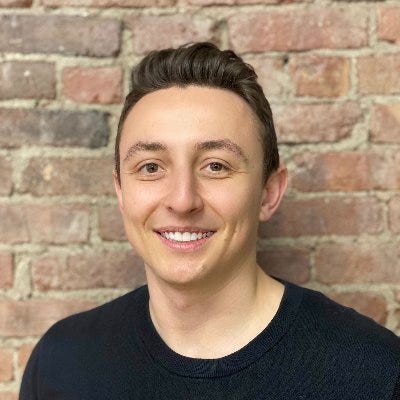We asked several healthcare executives to share their health IT predictions and trends for 2023.

Nate Maslak, the co-founder/CEO of Ribbon Health
Data Personalization: 38% of consumers want more personalized and inclusive healthcare options. In 2023, we’ll see a greater shift towards healthcare enterprises prioritizing this personalization, by innovating their current data infrastructure to show a range of information that lets a patient make an educated care decision based on what matters most to them.

Julian Harris, MD – CEO of ConcertoCare
There are 76 million baby boomers who will be 65 by 2030, and they want a better, easier way to receive health care where they prefer it most — in their homes. In 2023, I expect we will continue to see accelerated demand for and investment in tech-enabled delivery of at-home care for seniors, especially given the growing prevalence of chronic conditions in this age group and the impact that has on healthcare spending and outcomes in the country. As we head into 2023, there’s a real opportunity for CMS to strengthen the value-based care models that make this type of innovative care happen.

Amy Brown, CEO of Authenticx
Companies throwing technology at their staffing shortfalls — without first understanding the problem they’re solving for and how it actually impacts the customer experience — will be an utter failure. Spending millions of dollars on the latest digital innovation or optimization transformation won’t solve the patient experience and will ultimately hurt the company’s business. Some healthcare organizations say they’re in the business of improving patient experiences when they’re actually digitally optimizing and simply adding more technology to cover staffing shortages or eliminate overhead. Leaders must use technology to listen at scale to patients and know how and when to enable digital solutions and the staff they do have to do their best work.

Oliver Kharraz, CEO & Founder, Zocdoc
Savvy care organizations will increasingly use physician extenders to offer more appointment inventory, grow revenue, and increase access to care.
As the costs of operating a healthcare practice or hospital rise, and staffing and burnout issues add additional stressors, the medical community is facing unprecedented times. Savvy practice and system leaders will make good use of physician extenders, who can help close financial and labor gaps. Physician extenders can help open up more appointment capacity, and reduce the workload of physicians by managing patient communication, filling prescriptions, and taking on relevant clinical tasks. Additionally, higher physician extender to physician ratios can significantly reduce costs by improving physician efficiency; physicians can focus on the more complex cases. Physician extenders will help close the care gap for patients, while increasing revenue for medical practices.

Florian Otto, CEO at Cedar
Healthcare Consumers Will Vote With Their Feet: We’re seeing consumers find and stay with providers that give them the best end-to-end experience beyond just their clinical visit. These days, the quality of a consumer’s clinical visit is now table stakes, and the experience before and after an appointment make the difference between a repeat customer or a one-time visit. Unfortunately, a lot of providers are still offering poor administrative quality. In the coming year, providers must double down on a holistic experience, both in-person and digital, to put the consumer at the center of the healthcare ecosystem. To do so, providers will need to think beyond their individual relationship with the consumer and instead work with all stakeholders to provide a united source of truth and communication. Those that do will see the greatest amount of return by way of patient foot traffic.

Ariel Katz, CEO & Co-Founder at H1
The US will become the leader in healthcare data democratization. Next year, we’ll see more initiatives aimed at democratizing and digitizing healthcare data so we can use it to foster innovation, bring drugs to market faster, and ultimately improve patient care. While a few countries have set the stage – Brazil’s DATASUS provides an integrated and open healthcare database, and Israel captures all patient data digitally from birth to death – we predict that the US will emerge as the leader in 2023. We’ve seen the value that using de-identified data can have on improving patient outcomes, and with recent federal regulations requiring that patients have digital access to their full health records, US healthcare companies will place a greater emphasis on and investment in data democratization and digitization.

Brett Vokey, Founder and CEO of BreatheSuite
The healthcare industry as we knew it has been forever altered by the global pandemic. Physicians and their patients have increasingly been relying on virtual care and remote patient monitoring (RPM) solutions as the industry evolves to accommodate COVID-19. I expect the forward momentum of virtual care and RPM will continue in the coming year due to their convenience, positive impact on patient outcomes and potential to reduce costs.
For example, 90 percent of people in the U.S. using a Metered-Dose Inhaler (MDI) are using it incorrectly and 66 percent are not adherent to the medication as prescribed (skipping doses, etc.). Inhaler misuse makes up about $5- $7 billion of the approximately $25 billion spent on inhalers annually. While physicians can identify incorrect inhaler technique through visual observation, but it is not possible to critique their patient every time they use a Metered-Dose Inhaler (MDI). Connected respiratory devices leverage technology that tracks, scores and provides cloud-based feedback on inhaler usage to users and, with consent, their care teams can ensure people are getting the most out of their inhaler.

Bronwyn Spira is the CEO and Co-Founder of Force Therapeutics
Since CMS released the new CPT codes for remote therapeutic monitoring (RTM) earlier this year, providers are finally being acknowledged for the time they spend connecting with patients outside the office. In 2023, it will be easier to make high-quality musculoskeletal care more accessible to minority and lower-income populations who are much less likely to have orthopedic surgery – and more likely to experience poor outcomes when they do. RTM, through digital care management tools, can enable individualized care pathways based on the patient’s demographics, social determinants of health, and clinical status. Immediate adjustments to the care plan can be made according to the patient’s reported pain, range of motion, and adherence to remote physical therapy. By enabling high-quality personalized education for patients who may be unable to present for in-person care due to financial, logistical, or motion challenges, a broader set of patient populations can have access to needed care as telehealth is increasingly accepted.

Piotr Orzechowski, Co-Founder and CEO of Infermedica
On the state of healthtech funding: Starting around Q2 we observed a downturn when it comes to venture funding, especially later stage. In fact Q3 ’22 was the lowest quarterly total in digital health funding in the past 11 quarters. Given clear macro-economic challenges and looking at performance of some of the leading public telehealth companies, investors have become more conservative this year but I believe this is a rather temporary trend. Great companies will still get funded, and the amount of capital available in the market is substantial. I believe that starting from Q2 2023 the digital health funding situation will gradually improve and will recover by mid-2024 bringing investor’s sentiment back on track.

Saket Saurabh, Founder and CEO of Nexla
Data Mesh Takes a Backseat But Data Products Will Push on Ahead in 2023: With the economy in a slowdown, we can expect data mesh— frameworks that bring scale to enterprise wide data adoption — to take a backseat. 2023 will be the year of data products before the industry moves towards data mesh in 2024 and beyond.

Yossi Bahagon, Chairman of Sweetch
Closing the Equity Gap: We will see more programs implemented that bridge the equity gaps in chronic care management, obesity, diabetes, and preventive care, among other areas.

Mike Peluso, Chief Technology Officer at Rectangle Health
In 2021, we saw that patients were actively seeking digital tools to the point where they were changing providers to add technology to their healthcare. As the calendar turns to 2022, we expect to see continued growth in popularity of digital healthcare management tools like text communications, digital wallets, text-to-pay, payment plans, and QR codes that point to digital portals.
Practices are seeing the benefits of replacing outdated payment collection processes that involve manual data entry, paper-based billing, and follow-up phone calls. These digital payment options get practices paid faster and increase patient convenience and, in turn, loyalty. The digital transformation is proving not to be a fad necessitated by COVID-19, but a way to find better connections between practices and patients.

Terrence Sims, Chief Strategy Officer, Raintree
The US population is aging rapidly. By 2040 we expect the population of those 65 and older to double. Today non-fatal falls account for $50B in healthcare spending, a number that is unlikely to diminish with an ageing population. However, most falls are preventable, and moving forward fall prevention will be a growing priority. This will drive an increased need for therapists to spend more time working directly with patients, and less time doing paperwork. Our population of care providers is limited, which increases the need for professionals to work as efficiently as possible. In 2023 and beyond, the healthcare industry will be making major technology, operational and manpower investments into solving the non-fatal fall challenge.

Vince King, Chief Commercial Officer at TailorMed
Taking a note from Disney – patient experience at the forefront of healthcare
The pandemic heightened patient demand for digital engagement – and in 2023, healthcare leaders will lean into the digital acceleration, identifying new avenues to connect with patients and amplify the patient experience. We’ll see more healthcare entities hiring individuals from companies including Disney and Carnival with top-tier customer experiences to optimize the patient journey and experience in a way the healthcare industry has not previously prioritized.
However, there will be a learning curve as the industry finds a healthy balance of how to engage patients and when. Understanding who the patient is and where they are at each step of their journey will be key to engaging logically and strategically. Patients need the right data at the right time to take the right action – whether that is filling out automated intake forms or engaging in the billing process following care. Aligned incentives across healthcare stakeholders will be critical in this process, working to improve care coordination and delivery. The more successful healthcare is at engaging with patients digitally, the more the industry can ask consumers to engage in more aspects of their care, and the greater momentum we’ll see next year and beyond.

Chris Luoma, SVP of Global Product Management at GHX
Over the last two years, healthcare has seen increased adoption of solutions like cloud ERPs and electronic invoicing,” said Chris Luoma, Senior Vice President, Global Product Management, GHX. “As the need for digital transformation increases, this trend will continue. We are starting to see provider organizations that were early cloud ERP adopters mature their cloud strategies, allowing them to think about how they can change the way they operate their businesses and drive greater efficiency. Examples of this include deploying ERP into non-acute settings to drive efficiencies that previous, on-premise systems were not able to reach, extending their systems further with robotic process automation, artificial intelligence and machine learning to reduce manual tasks and creating overarching data strategies that bring together financial, clinical and supply chain data to drive insights that help improve patient care. Despite the upfront costs of digital transformation initiatives, we expect to see more forward-thinking healthcare executives make the near-term investment, even amid financial pressures, to support the long-term growth and health of their organizations.

Karen Kobelski, Business Unit Vice President & General Manager, Health, Clinical Surveillance, Compliance & Data Solutions at Wolters Kluwer
Patient safety will improve with regulatory oversight of healthcare technology – particularly around the emerging software in the medical device space. With increasing regulations, hospitals and health systems now face greater hurdles using and maintaining technology built in-house. In 2023, we expect clinical leaders trying to build solutions will experience pushback from internal legal and regulatory teams challenged to manage the burden of compliance. Many hospital leaders will turn to proven, clinically validated, and compliant tools in lieu of building their own solutions. By partnering with companies that have already taken on this burden of compliance, health system leaders will be able to keep internal teams focused on providing the best care to patients.

Dr. George Gellert, Medical Advisor for Value Demonstration at Infermedica
Demonstrating ROI: Despite healthcare IT being central to and a vehicle for not only clinical care delivery, but all operational and financial aspects of health system performance, truly robust evidence-based evaluation of impact, value and ROI remains a “nice to have” rather than an imperative. Most health IT companies are held to a low standard of evidence of value and proof of ROI through marketing white papers and quantification that is not robust or systematically evaluated, rather than being required to demonstrate value through scientific peer review and journal publication. This has not served the interests of health systems and care delivery organizations, clinicians or patients well. Health IT solutions, which profoundly influence and impact care delivery and organizational performance, should have to scientifically demonstrate value – much as drug therapies, medical devices, and other diagnostic and therapeutic technologies do. Only when scientific research on health IT impact and value demonstration is regarded as being as important to healthcare delivery as clinical trials, will spending on health IT become rational and systematic.

Brian Doyle, Rectangle Health’s VP of Enterprise Sales
Following a year of economic uncertainty, increased expenses, and staff burnout, many practices will need to address these challenges and those that lie ahead in the new year. As 2023 approaches, providers seek new solutions to streamline administrative workloads while providing top-notch care. The solution to many of these problems lies in digital transformation: an advanced digital footprint can effectively streamline and automate administrative workloads, improve the patient experience, and mitigate employee burnout — equipping providers and patients with an enhanced healthcare experience.
The benefits of enhancing one’s digital footprint are many. For starters, digital transformation allows patients to sign up for appointments online while allowing practices to manage all appointments on the back end. Customizable texts remind patients of appointments, send links to payments, or announce new check-up openings. Technology can offer several options for patients to pay their medical bills — whether from their mobile device, laptop, or the office with contactless payments like Apple Pay — and offer payment installment programs to help ease the financial burden. Not only does this enhance the overall patient experience, but it also increases the practice’s bottom line. Patients and practices will benefit by simplifying the business side of healthcare through a digital transformation. Starting the new year with an advanced digital footprint gives providers the tools to rise to new challenges and meet evolving patient demands, optimizing the healthcare experience for all.

Marie Lamont, Global RWE Data Strategy, Access & Enablement at IQVIA and General Manager at Inteliquet
Data harmonization on the results of genetic testing and research is required for us to effectively use the millions of data points for more than one trial. By reusing this information across various studies, researchers can have broader insights into uncovering methods to better the lives of patients in a faster manner. The question before us is how to do so and which is the correct data format to standardize on. In 2023, the industry will begin to look at how to solve this challenge to better formulate and build upon the millions of data points already being collected in a cohesive manner.

Arun Nagdev, M.D., Sr. Director of Clinical Education at Exo, and Director of Emergency Ultrasound at Alameda Health System
The siloed nature of healthcare, and how to fix it in 2023: The biggest challenge that physicians face today is the siloed nature of healthcare. Across various care settings, patient-focused medicine is missing, and the losers of this game will always be the patients and their physicians. Moving forward, we should see more patient data flowing into electronic medical records across all care settings – both inpatient and outpatient. This will enable care teams across the continuum to have the insights they need to better, and more efficiently, care for their patients. By providing informed, superior care from the get-go, this will also help prevent patient readmission and backlogs.
